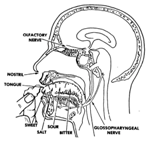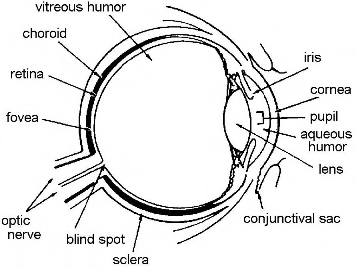INTRODUCTION
1 ANATOMY AND PHYSIOLOGY OF THE SENSORY SYSTEM
Section I. General
Section II. The Special Sense of Vision (Sight)
Section III. The Special Sense of Hearing (Auditory)
Section IV. The Special Sense of Smell (Olfaction)
Section V. The Special Sense of Taste (Gustation)
Exercises
2 PHYSICAL ASSESSMENT OF THE SENSORY SYSTEM (HEENT)
Exercises
3 EENT DISEASES AND DISORDERS
Section I. Ocular Diseases and Disorders
Section II. Conditions of the Ear
Section III. Nasal Conditions/Throat Conditions
Exercises
4 HEENT TRAUMA
Section I. Head Injuries
Section II. Eye Injuries
Section III. Ear Injuries/Disorders
Section IV. Nose Injuries
Section V. Throat Injuries
Exercises
------------------------
LESSON 1
ANATOMY AND PHYSIOLOGY OF THE SENSORY SYSTEM
Section I. GENERAL
1-1. INTRODUCTION
The ability to sense stimuli is vital to man's
survival. If pain could not be sensed, burns would be common. Internal
problems such as an inflamed appendix or a stomach ulcer could be
unnoticed without pain. Without sight there is a greater risk of
injury from obstacles. Harmful gas could be inhaled if there were no
sense of smell.
Loss of a sense of hearing would keep us from
recognizing hazards such as automobile horns. And if there were no
taste, toxic substances could be ingested. If we could not "sense" out
environment and make the necessary adjustments, we probably could not
survive on our own.
NOTE: In this subcourse, you will see the letters
EENT and HEENT. EENT stands for eyes, ears, nose, and throat. HEENT
stands for head, eyes, ears, nose, and throat.
1-2. THE SENSORY PATHWAYS
a. Sensations. The body is continuously
bombarded by types of information called stimuli (stimulus, singular).
Those few stimuli which are consciously perceived (in the cerebral
hemispheres) are called sensations. Structures that detect changes in
man's external and internal environment produce sensations on the
senses.
b. Senses and Receptions. The senses and the
location of their receptors are as follows:
(1) Vision--receptors in the eyes.
(2) Smell--receptors in the nose.
(3) Hearing--receptors in the ears.
(4) Taste--receptors in the tongue.
(5) Touch, heat, cold, pain --receptors in the skin.
(6) Position--receptors in the muscles, joints,
inner ear.
(7) Hunger, thirst--receptors in the tongue, pharynx, mouth.
c. Two Types of Senses. They are differentiated by the type
of sensation they cause. Special senses are produced by receptors
limited to small areas such as the tongue, nose, balance, hearing,
vision, smell, and taste. General senses are produced by receptors
scattered throughout the body such as pressure, temperature, pain,
position, and touch.
d. Sensation and Perception. In its broadest
meaning, sensation refers to man's state of being aware of external or
internal conditions of the body. The state of being aware of something
through the senses is perception. Four conditions must take place for
a sensation to occur.
(1) A stimulus--a change in the environment which
causes a response by the nervous system.
(2) A receptor or sense organ-- picks up a stimulus
and converts it to a nerve impulse.
(3) Conduction--the impulse must be conducted from
the receptor or sense organ along a pathway to the brain.
(4) Translation--the impulse must be translated into
a sensation when the impulse is in a region of the brain.
From The
Sensory System


